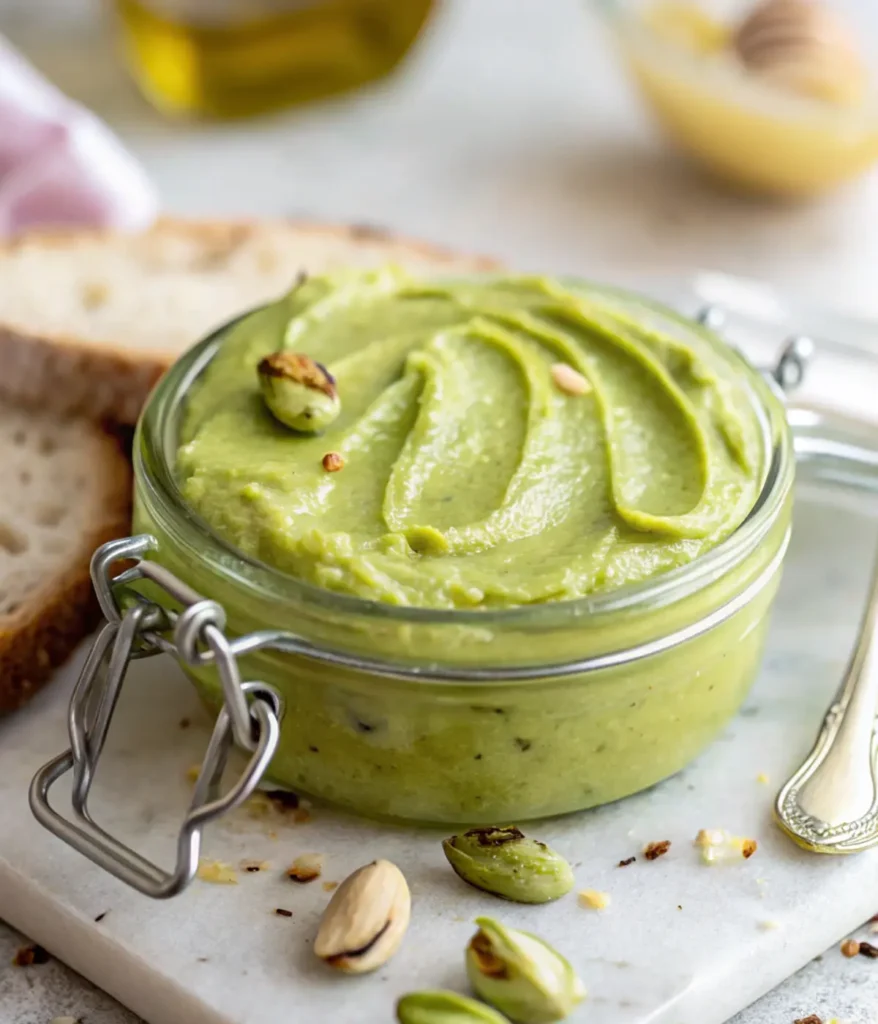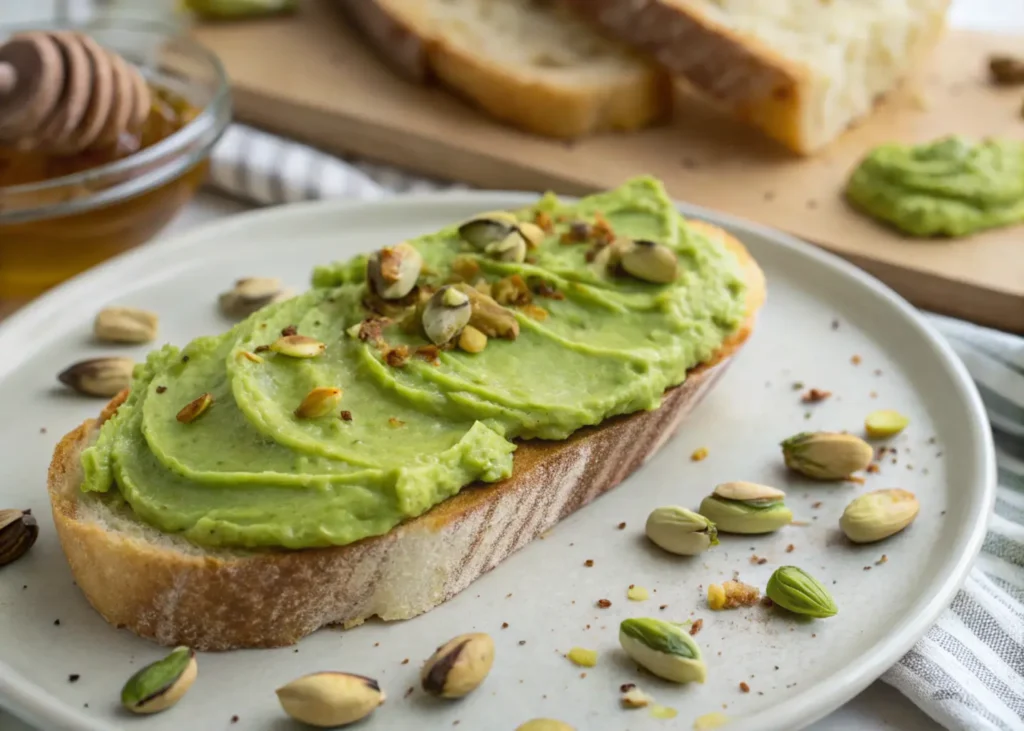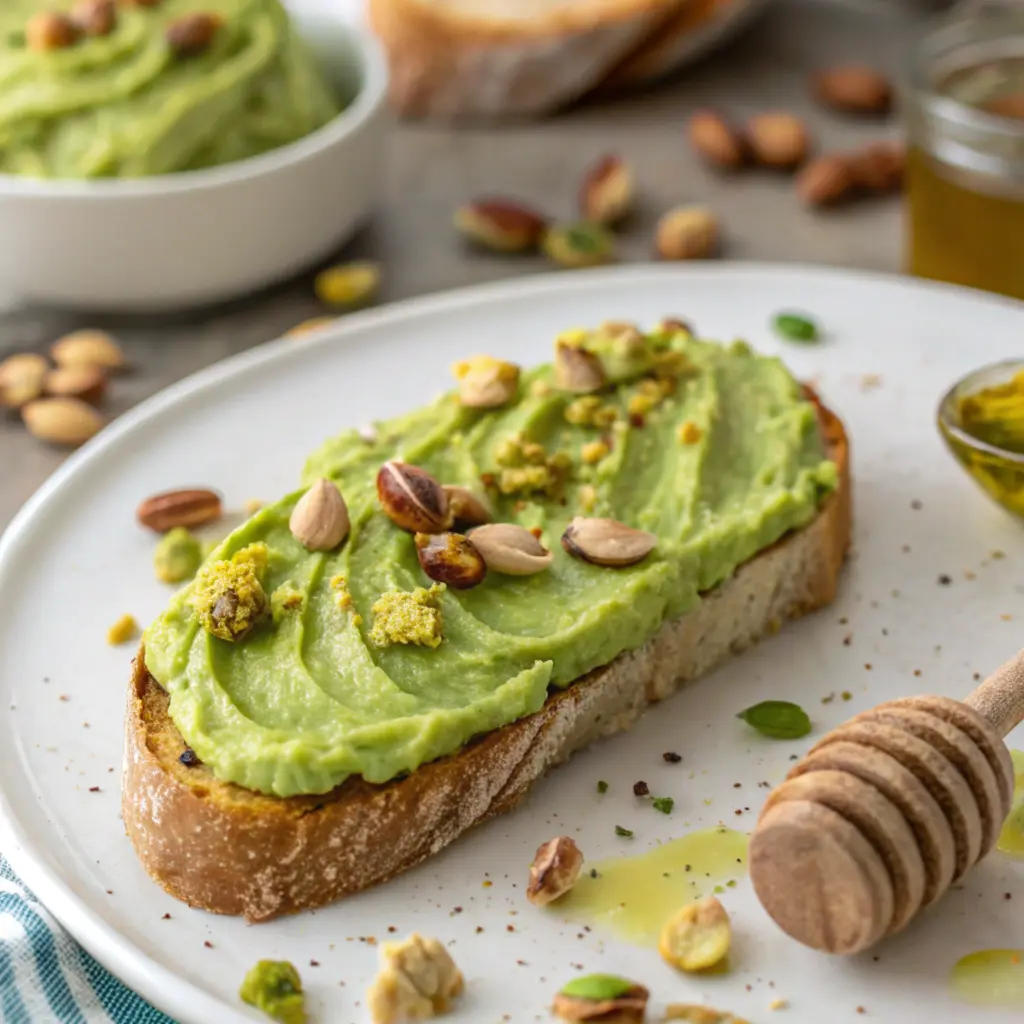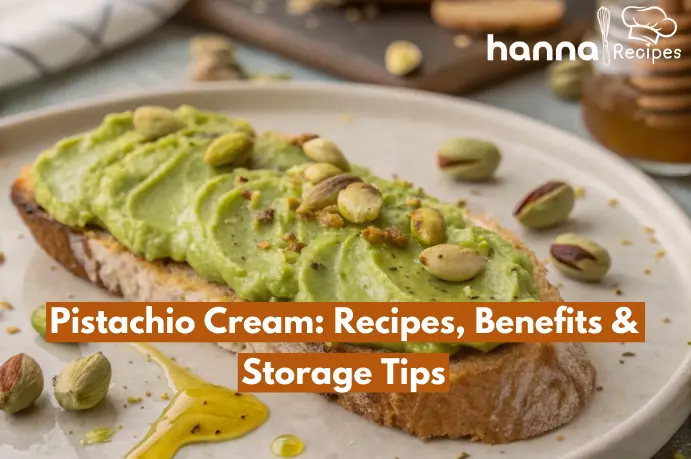introduction
Pistachio cream is a rich, smooth spread made mainly from finely ground pistachios mixed with sweeteners and oils. Known for its bright green color and creamy texture, this luxurious spread is loved for its unique nutty flavor and smooth consistency. It has become a versatile ingredient in both sweet and savory dishes, adding a special taste to many recipes. With its growing popularity, it is now a key item in gourmet kitchens around the world. Whether used as a sweet dessert filling or a refined addition to savory dishes, its balance of sweetness and pistachio flavor makes it a favorite among food lovers.
Origins and History
The origins of pistachio cream can be traced back to the Mediterranean region, particularly in Italy, where pistachios hold a special place in Sicilian culinary traditions. Over time, its distinctive flavor has gained global appeal, becoming a symbol of artisanal excellence. The rise in natural food trends has further solidified pistachio cream as a sought-after ingredient for home cooks and chefs alike. Learn how other traditional ingredients are making waves with authentic recipe guides.
Ingredients in Pistachio Cream
Primary Ingredients: Pistachios, Sweeteners, and Oils
The base of pistachio cream is built on simple, high-quality ingredients. Pistachios are the main ingredient, giving the cream its rich flavor and smooth texture. Sweeteners like sugar or honey are added to boost the natural nutty taste without overwhelming it. Neutral oils, such as sunflower or olive oil, help create a silky consistency. Each ingredient is chosen to keep the true pistachio flavor while adding a creamy texture. Some recipes also use a small amount of salt to balance the sweetness and enhance the overall flavor. If you’re curious about other ingredient pairings, explore this guide to complementary flavors.
Variations Across Cultures
While the core ingredients remain consistent, the preparation of pistachio cream varies across cultures. In Italy, for instance, it is often enriched with high-quality Sicilian pistachios, prized for their vibrant color and intense flavor. Middle Eastern versions may include rose water or cardamom, adding aromatic depth to the cream. In France, it is frequently used in patisserie, blended with cream or butter to create a rich filling. These cultural adaptations highlight the versatility of pistachio cream and its ability to complement diverse culinary traditions.

How is Pistachio Cream Made?
Step-by-Step Guide to Making Pistachio Cream at Home
Creating pistachio at home is a straightforward process. Follow these steps for a homemade version:
- Gather Ingredients: 2 cups of shelled pistachios, ½ cup sugar, 3 tablespoons of neutral oil, and a pinch of salt.
- Blanch Pistachios: Boil the pistachios briefly, then remove their skins to achieve a smooth texture.
- Blend Ingredients: Using a food processor, blend the pistachios until they form a fine paste.
- Add Sweeteners and Oil: Gradually incorporate sugar and oil, blending until the mixture becomes creamy.
- Adjust Consistency: If the cream appears too thick, add a teaspoon of water or milk.
- Store: Transfer the pistachio to an airtight container and refrigerate.
Tools and Equipment Needed
To make pistachio , you’ll need basic kitchen tools such as:
- A food processor or blender
- A saucepan for blanching
- A spatula for scraping
- Airtight storage containers
These tools ensure that the process is efficient and the final product achieves the desired consistency.
Nutritional Value of Pistachio Cream
Caloric Content and Macronutrients
This spread is rich in nutrients, with most of its calories coming from healthy fats. A tablespoon usually contains about 90-120 calories, mostly from fats. It also offers moderate amounts of protein and carbohydrates, making it a filling addition to meals. Because of its high fat content, it’s important to control portions to keep it part of a balanced diet. In terms of macronutrients, it is high in monounsaturated fats, which are good for heart health.
Vitamins, Minerals, and Health Benefits
In addition to its macronutrients, pistachio cream is a great source of essential vitamins and minerals. It provides vitamin B6, magnesium, and potassium, which are important for overall health. The antioxidants in pistachios, like lutein and zeaxanthin, help support eye health. When eaten in moderation, it may also help lower cholesterol levels and improve skin health. Its strong nutritional profile makes it a satisfying treat when enjoyed in reasonable amounts.
Pistachio Cream vs. Other Nut Creams
Comparing Pistachio Cream with Almond, Cashew, and Hazelnut Creams
Each nut cream boasts unique characteristics, but pistachio stands out for its vibrant green color and distinct flavor. Compared to almond cream, which has a milder taste, it offers a more pronounced nuttiness. Cashew cream, known for its creamy texture, lacks the earthy undertones present in this spread. Hazelnut cream, often associated with chocolate spreads, leans towards a sweeter profile, whereas this cream maintains a balance of sweet and savory.
Flavor Profiles and Uses
The flavor of pistachio is both nutty and subtly sweet, with a creamy consistency that makes it versatile. It complements desserts, pairs well with savory dishes, and even enhances beverages. Its unique taste ensures it remains a favorite among chefs and home cooks alike.

Uses of Pistachio Cream in Culinary Arts
Desserts: Cakes, Pastries, and Ice Creams
Pistachio is a star ingredient in desserts. It adds richness to cakes, serves as a filling for pastries, and enhances the flavor of ice creams. For example:
- Use it as a frosting for pistachio-flavored cakes.
- Incorporate it into tart fillings for a nutty twist.
- Swirl it into vanilla ice cream for a luxurious treat.
Savory Dishes: Pairing with Cheeses and Meats
In savory applications, pistachio pairs beautifully with creamy cheeses like ricotta or mascarpone. It can also be used as a glaze for roasted meats, adding a sweet and nutty dimension. Transitioning from desserts to savory dishes, this versatile cream elevates any meal.
Beverages and Cocktails
Pistachio cream can also elevate beverages in exciting ways. For example, blend it into your coffee to create a creamy pistachio latte, adding a rich, nutty twist to your morning. It can also serve as a base for unique cocktails, offering a smooth, indulgent flavor that pairs perfectly with spirits like rum or bourbon. Its nutty taste and velvety texture make it a delightful addition to both hot and cold drinks, turning ordinary beverages into extraordinary treats. Whether you’re making a cozy drink or a sophisticated cocktail, pistachio adds a touch of luxury to any beverage.
Popular Brands of Pistachio Cream
Top-Selling Pistachio Cream Brands Worldwide
Several brands have gained recognition for their high-quality pistachio cream. Notable names include:
- Fiasconaro: Known for their Sicilian pistachio spreads.
- Nutland: Praised for their organic offerings.
- Bacco: Specializing in artisanal pistachio products. These brands prioritize quality ingredients and traditional methods, ensuring an authentic experience.
Organic and Artisanal Options
For those seeking natural options, organic and artisanal pistachio is widely available. These products often feature sustainably sourced pistachios and avoid artificial additives, making them a great choice for health-conscious consumers. Additionally, choosing organic and artisanal varieties supports eco-friendly farming practices, providing an extra appeal for those focused on both quality and sustainability. By selecting these options, you not only make a healthier choice for yourself but also support ethical production methods.

How to Store Pistachio Cream
Optimal Storage Conditions: Temperature and Containers
To maintain its quality, pistachio cream should be stored in a cool, dry place. Additionally, it is important to use airtight containers to prevent exposure to air, which can lead to oxidation and spoilage. Furthermore, refrigeration is recommended if the cream contains no preservatives, as this will help extend its shelf life and preserve its freshness. By following these simple storage tips, you can ensure the pistachio cream stays at its best for a longer period.
Shelf Life and Signs of Spoilage
The shelf life of pistachio cream varies depending on its ingredients and storage conditions. Typically, it lasts 3-6 months when stored properly. Signs of spoilage include a rancid smell, changes in texture, or visible mold. Regularly checking these indicators ensures the cream remains safe to consume.
The Economic Impact of Pistachio Cream
Role in Pistachio Farming and Global Trade
The production of pistachio cream plays a crucial role in the pistachio farming industry. As demand for this spread increases, it not only encourages more pistachio cultivation but also supports farmers and boosts local economies. Furthermore, on a global scale, the growing popularity of pistachio cream contributes significantly to the nut trade, further underscoring its economic importance. Consequently, this expanding market continues to drive growth and prosperity within the industry.
Market Trends and Consumer Demand
Consumer demand for premium and natural products has driven the growth of the pistachio cream market. Trends like clean labeling and plant-based diets have made it even more appealing. With its distinct flavor and versatility, this spread is set to continue being a popular choice in the culinary world.
DIY Pistachio Cream Recipes
Pistachio cream is a rich and velvety spread celebrated for its versatility in both sweet and savory recipes. Crafting your own pistachio cream at home allows you to control the ingredients and customize flavors. Whether you’re a novice or an experienced cook, there’s a recipe for everyone.
Quick and Easy Recipe for Beginners
For beginners, starting with a simple pistachio cream recipe can be rewarding. Begin by gathering these essential ingredients:
- 1 cup unsalted pistachios
- ½ cup powdered sugar
- ½ cup white chocolate
- ¼ cup milk or plant-based milk
- 1 tsp vanilla extract
Instructions:
- Blanch the pistachios by boiling them for a minute, then remove their skins.
- Blend the pistachios in a food processor until a fine paste forms.
- Melt the white chocolate in a double boiler, then add it to the pistachio paste.
- Combine the sugar, milk, and vanilla, blending until smooth.
This quick method produces a creamy and delicious spread in under 30 minutes. Use it as a topping for toast, pancakes, or even a swirl in your coffee.
Advanced Gourmet Recipe
For those with more experience, an advanced pistachio cream recipe delivers a deeper flavor profile. Here’s what you’ll need:
- 2 cups raw pistachios
- ½ cup granulated sugar
- ½ cup heavy cream or coconut cream
- 2 tbsp pistachio oil
- A pinch of sea salt
Instructions:
- Toast the pistachios in an oven at 350°F for 10 minutes to enhance their natural aroma.
- Blend the pistachios until smooth, adding pistachio oil gradually.
- Cook the sugar and cream on low heat, stirring until sugar dissolves.
- Incorporate the pistachio paste, blending until the mixture achieves a luxurious texture.
This gourmet version pairs wonderfully with desserts like macarons, ice cream, or layered cakes.
Allergen and Dietary Considerations
Pistachio cream can be easily tailored to fit various dietary needs. By understanding potential allergens and dietary preferences, you can ensure that your creations are not only inclusive but also enjoyable for everyone. Additionally, this attention to dietary requirements allows for a wider range of people to savor your delicious treats without concerns.
Gluten-Free, Vegan, and Keto-Friendly Adaptations
Adapting pistachio cream for specific diets is straightforward. Here are some tips:
- For gluten-free diets: Ensure all ingredients, especially add-ins like chocolate, are certified gluten-free.
- For vegans: Substitute dairy with plant-based options like almond milk, coconut cream, and dairy-free white chocolate.
- For keto enthusiasts: Use sugar substitutes like erythritol or monk fruit sweetener instead of regular sugar.
Common Allergens in Pistachio Cream
While pistachio cream is nut-based, it’s essential to address common allergens. Cross-contamination with peanuts or tree nuts may occur during processing. Always:
- Check ingredient labels for allergen warnings.
- Use dedicated tools and appliances for nut-free adaptations.
- Inform consumers about the presence of pistachios to avoid allergic reactions.
Environmental Impact of Pistachio Production
The journey of pistachios from farm to table has environmental implications. Supporting sustainable practices ensures the long-term availability of this beloved nut.
Sustainability Practices in Pistachio Farming
Pistachio farming has adopted various sustainable methods, such as:
- Water-efficient irrigation systems: Pistachios require less water than almonds, making them a more eco-friendly option.
- Organic farming techniques: Reducing pesticide use preserves soil health and biodiversity.
- Carbon footprint reduction: Many producers invest in renewable energy for processing.
By choosing brands that prioritize sustainability, consumers can enjoy pistachio cream guilt-free.
Challenges in Large-Scale Production
Despite advancements, large-scale pistachio production faces challenges:
- Climate change impacts: Shifting weather patterns affect crop yields and quality.
- Resource constraints: Managing water and land resources efficiently is critical.
- Market demands: Balancing quality with scalability remains a constant hurdle.
FAQs
Is pistachio cream healthy?
Yes, pistachio cream is a nutrient-rich spread. It contains healthy fats, protein, and antioxidants. However, its calorie content can be high because of added sugars and oils, so it’s important to enjoy it in moderation.
How is pistachio cream different from pistachio butter?
While both are nut-based spreads, pistachio cream usually contains added sugar, oils, and sometimes milk, giving it a sweeter and smoother texture. Pistachio butter, on the other hand, is made from pure ground pistachios with no additives, resulting in a thicker consistency.
Can I freeze pistachio cream?
Yes, pistachio cream can be frozen for up to three months. Store it in an airtight container to prevent freezer burn. Thaw it in the refrigerator overnight and stir well before use.
What dishes can I make with pistachio cream?
The culinary possibilities with pistachio cream are endless. Use it in:
- Desserts like tarts, cakes, and pastries
- Breakfast items such as waffles and smoothies
- Savory dishes like pasta sauces or as a dip for cheese boards
Is pistachio cream vegan?
Many pistachio cream recipes can be vegan if they exclude dairy-based ingredients. Always check the label or prepare a homemade version with plant-based substitutes.
Where can I buy authentic pistachio cream?
Authentic pistachio cream is available in specialty stores, online retailers, and gourmet shops. Look for brands with minimal additives and high-quality ingredients to ensure a premium experience.
Conclusion:
Pistachio cream’s versatility and delicious flavor make it a favorite among culinary enthusiasts. Whether you’re preparing a quick snack, enhancing a dessert, or exploring its sustainable qualities, pistachio cream is a cherished and adaptable ingredient. Its rising popularity shows a global love for this luxurious spread, ensuring it stays a staple in kitchens around the world.


1 thought on “Pistachio Cream: Recipes, Benefits & Storage Tips”
Comments are closed.